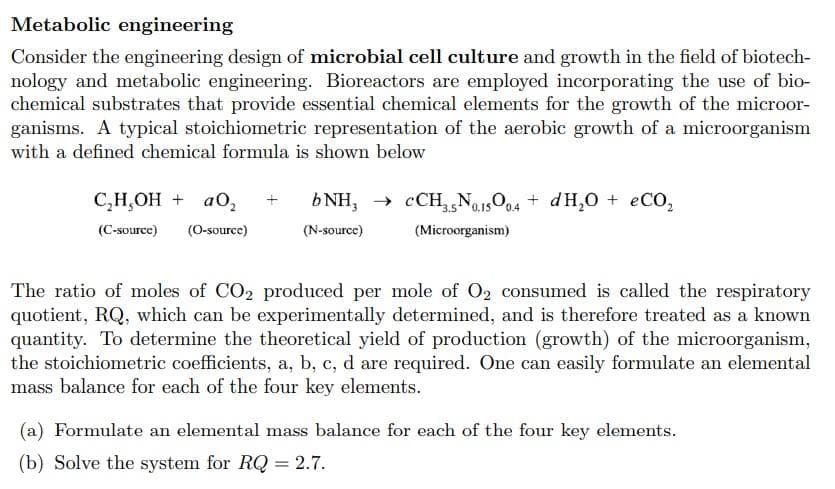Metabolic engineering Consider the engineering design of microbial cell culture and growth in the field of biotech- nology and metabolic engineering. Bioreactors are employed incorporating the use of bio- chemical substrates that provide essential chemical elements for the growth of the microor- ganisms. A typical stoichiometric representation of the aerobic growth of a microorganism with a defined chemical formula is shown below С, Н, ОН + а0, b NH, → cCH, No.15O04 + dH,0 + eCO, (C-source) (O-source) (N-source) (Microorganism) The ratio of moles of CO2 produced per mole of O2 consumed is called the respiratory quotient, RQ, which can be experimentally determined, and is therefore treated as a known quantity. To determine the theoretical yield of production (growth) of the microorganism, the stoichiometric coefficients, a, b, c, d are required. One can easily formulate an elemental mass balance for each of the four key elements. (a) Formulate an elemental mass balance for each of the four key elements. (b) Solve the system for RQ = 2.7.
Metabolic engineering Consider the engineering design of microbial cell culture and growth in the field of biotech- nology and metabolic engineering. Bioreactors are employed incorporating the use of bio- chemical substrates that provide essential chemical elements for the growth of the microor- ganisms. A typical stoichiometric representation of the aerobic growth of a microorganism with a defined chemical formula is shown below С, Н, ОН + а0, b NH, → cCH, No.15O04 + dH,0 + eCO, (C-source) (O-source) (N-source) (Microorganism) The ratio of moles of CO2 produced per mole of O2 consumed is called the respiratory quotient, RQ, which can be experimentally determined, and is therefore treated as a known quantity. To determine the theoretical yield of production (growth) of the microorganism, the stoichiometric coefficients, a, b, c, d are required. One can easily formulate an elemental mass balance for each of the four key elements. (a) Formulate an elemental mass balance for each of the four key elements. (b) Solve the system for RQ = 2.7.
Chemistry
10th Edition
ISBN:9781305957404
Author:Steven S. Zumdahl, Susan A. Zumdahl, Donald J. DeCoste
Publisher:Steven S. Zumdahl, Susan A. Zumdahl, Donald J. DeCoste
Chapter1: Chemical Foundations
Section: Chapter Questions
Problem 1RQ: Define and explain the differences between the following terms. a. law and theory b. theory and...
Related questions
Question

Transcribed Image Text:Metabolic engineering
Consider the engineering design of microbial cell culture and growth in the field of biotech-
nology and metabolic engineering. Bioreactors are employed incorporating the use of bio-
chemical substrates that provide essential chemical elements for the growth of the microor-
ganisms. A typical stoichiometric representation of the aerobic growth of a microorganism
with a defined chemical formula is shown below
C,H,OH + a0,
b NH, - cCH, No.15004 + dH,0 + eCO,
3.5
(C-source)
(O-source)
(N-source)
(Microorganism)
The ratio of moles of CO2 produced per mole of O2 consumed is called the respiratory
quotient, RQ, which can be experimentally determined, and is therefore treated as a known
quantity. To determine the theoretical yield of production (growth) of the microorganism,
the stoichiometric coefficients, a, b, c, d are required. One can easily formulate an elemental
mass balance for each of the four key elements.
(a) Formulate an elemental mass balance for each of the four key elements.
(b) Solve the system for RQ = 2.7.
%D
Expert Solution
This question has been solved!
Explore an expertly crafted, step-by-step solution for a thorough understanding of key concepts.
This is a popular solution!
Trending now
This is a popular solution!
Step by step
Solved in 2 steps

Knowledge Booster
Learn more about
Need a deep-dive on the concept behind this application? Look no further. Learn more about this topic, chemistry and related others by exploring similar questions and additional content below.Recommended textbooks for you

Chemistry
Chemistry
ISBN:
9781305957404
Author:
Steven S. Zumdahl, Susan A. Zumdahl, Donald J. DeCoste
Publisher:
Cengage Learning

Chemistry
Chemistry
ISBN:
9781259911156
Author:
Raymond Chang Dr., Jason Overby Professor
Publisher:
McGraw-Hill Education

Principles of Instrumental Analysis
Chemistry
ISBN:
9781305577213
Author:
Douglas A. Skoog, F. James Holler, Stanley R. Crouch
Publisher:
Cengage Learning

Chemistry
Chemistry
ISBN:
9781305957404
Author:
Steven S. Zumdahl, Susan A. Zumdahl, Donald J. DeCoste
Publisher:
Cengage Learning

Chemistry
Chemistry
ISBN:
9781259911156
Author:
Raymond Chang Dr., Jason Overby Professor
Publisher:
McGraw-Hill Education

Principles of Instrumental Analysis
Chemistry
ISBN:
9781305577213
Author:
Douglas A. Skoog, F. James Holler, Stanley R. Crouch
Publisher:
Cengage Learning

Organic Chemistry
Chemistry
ISBN:
9780078021558
Author:
Janice Gorzynski Smith Dr.
Publisher:
McGraw-Hill Education

Chemistry: Principles and Reactions
Chemistry
ISBN:
9781305079373
Author:
William L. Masterton, Cecile N. Hurley
Publisher:
Cengage Learning

Elementary Principles of Chemical Processes, Bind…
Chemistry
ISBN:
9781118431221
Author:
Richard M. Felder, Ronald W. Rousseau, Lisa G. Bullard
Publisher:
WILEY